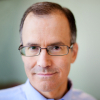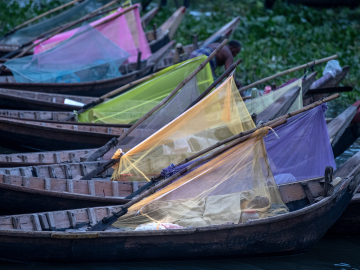“Like a Nightmare”: Amy Maxmen on Konzo
A veteran science journalist who has covered everything from West Africa’s Ebola outbreak, Crispr gene editing, malaria prevention and the Cambrian explosion, Amy Maxmen had never encountered anything like konzo.
The paralytic disease caused by a drought-resistant variety of cassava that harbors cyanide has afflicted perhaps 100,000 people in the Democratic Republic of Congo alone. No one knows the true number of people affected in DRC and other African countries because no epidemiologic surveillance of the neurotoxic disease has ever been done—likely because it afflicts the poorest of the poor. To report on the disease, Maxmen traveled in July to Kahemba, an isolated town in DRC known as “the place of suffering” because of the large number of people suffering from konzo there.
In this Q&A, Maxmen reflects on her experience reporting konzo in the DRC, how it affected her and her hopes for change.
Your descriptions of Kahemba sounded horrific—perhaps 1 in 10 people crippled by konzo. People seem to have a terrible choice: Starve or eat poisoned food. What was it like there?
It was horrific. I remember it like a nightmare. Neil Brandvold, the photographer for this series, was similarly stunned. He told me how hard it was to turn his camera on people as they struggled to walk. Of course, we hope this series brings about some sort of change. But that’s never guaranteed. As for the people with konzo, they were eager to tell me about their conditions because it can seem like no one cares.
Are they angry about the disease—or resigned to it?
They have responded to the disease in different ways. Some people, such as Gaby, the love-struck man I wrote about in my second story, are upset that there aren’t programs to help people who have been crippled by konzo find jobs. That’s so important because work provides income, integrates a person into society, and gives them a sense of pride. Others are resigned to their condition. And others are deeply depressed.
What affected you the most in your reporting in DRC for this series?
I’ll never forget talking with Etienne, the young man in a wheelchair in my third story. I usually have no shortage of questions, but I lost my words looking at him, his two malnourished young brothers, and his paralyzed mother. They are all stricken with konzo and have next to nothing to eat. When Etienne told me this was a sign of the End Times, I nodded. My translator asked me if I believe in such things, and I said maybe. Not because I’m religious, but because in the moment I had no alternative explanation for why such suffering exists. It’s heavy to report on people who may die soon after you leave them. I can’t truly know how they feel, but I know I feel powerless.
You reported on West Africa’s Ebola outbreak. Konzo seems to be almost the exact opposite: It’s completely under the global radar, it’s a slow-moving and persistent disease that isn’t transmitted person to person. Did this make your job harder?
This disease is harder to cover as a journalist because I want my stories to be read, and the public naturally cares about things that may affect them. Infectious diseases like Zika and Ebola are in that category because they can spread within the United States through mosquito bites and virus-laden sweat. But konzo cannot. It is unlikely to harm anyone except for people so poor that they have nothing to eat except for a single crop that can be toxic.
So, as a writer, I try to bring my audience in by focusing on elements of people’s lives that everyone can relate to as humans. That’s why I profiled a Congolese doctor and scientist who communicates so smoothly, and that’s why I structured another piece around a love story.
I also want to say that I would not have been able to write these pieces if Global Health NOW was not specifically interested in covering untold global health stories. That’s unusual for the reasons I mentioned above: Readers aren’t always interested in problems that don’t affect them, and therefore, neither are editors and publishers.
Perhaps 100,000 Africans are afflicted by this paralyzing neurotoxic disease and it’s been documented since the 1930s. Why haven’t developed countries responded? What would it take to get on the global health agenda?
Konzo is not on the global health agenda because it’s isolated among the extremely poor. I’m talking about those who live in remote regions, who have little or no decent land to farm, people who are chronically malnourished, who don’t have electricity, running water, bicycles… Often they don’t even own a cheap cell phone. Their physical and virtual distance from the rest of the world is like a wall. And because the disease is not infectious, it is not perceived as a threat to rich nations. But perhaps it should be. Just as extreme poverty can cause konzo, konzo prevents people from escaping poverty. And extreme poverty is a precarious state. It renders people vulnerable to konzo, as well as afflictions that spread like Ebola and conflict.
That’s my practical argument for why konzo should be on the global health agenda. The moral argument is that it’s wrong to stand by while people suffer when there’s more than enough money in the world to get them out of this state.
A good start to getting konzo on the global health agenda would be surveillance so that we know how many thousands of people have the disease.
Which intervention has the best hope of bringing real improvement to people’s lives?
The most urgent needs are funds to help people with konzo reinsert themselves into society through physical therapy and assistance in finding work. I’d be a proponent of sending cash directly to the local nurses who work with konzo patients and to people with konzo—but setting up a reliable system to get people cash is nontrivial.
And the most urgent intervention as far as prevention is concerned is a called the “wetting method,” which I describe in my third piece. Congolese neurologist and biochemist Desire Tshala -Katumbay is right now in the Congo, teaching community leaders this method so that they can pass it on to their peers over the years. Another researcher, Howard Bradbury, has set up a crowdfunding site to raise money for this cause. The method is good because it’s realistic and inexpensive. Locals can do it themselves, without having to wait on aid.
But ultimately, an end to extreme poverty is the only answer. The world-renowned epidemiologist who figured out the cause of konzo in the 1980s, Hans Rosling, says this is possible in fewer than 15 years. And the United Nations made it their priority in the Sustainable Development Goals. This is not an outlandish goal: The percent of people living in extreme poverty dropped by more than half over the past 25 years. However, last week, the World Bank published a report that shows this goal is now in jeopardy because the global economy has slowed, and the world’s poorest are increasingly isolated because of economic inequality.
To change this trajectory, we all need to think very hard about what keeps people poor, and how the international community, the private sector, and national governments can make policies that lift them out of this state.
Read the series intro and Maxmen’s 3 stories here.
Special thanks to the Pulitzer Center on Crisis Reporting for supporting photography for this series.
Please see also last year’s GHN coverage of mycetoma, The Most Neglected Disease, which was selected as the 2015 Untold Global Health Story.
And please join the thousands of subscribers who rely on Global Health NOW summaries and exclusive articles for the latest public health news. Sign up for our free weekday enewsletter, and please share the link with friends and colleagues: Subscribe to GHN
Neil Brandvold





